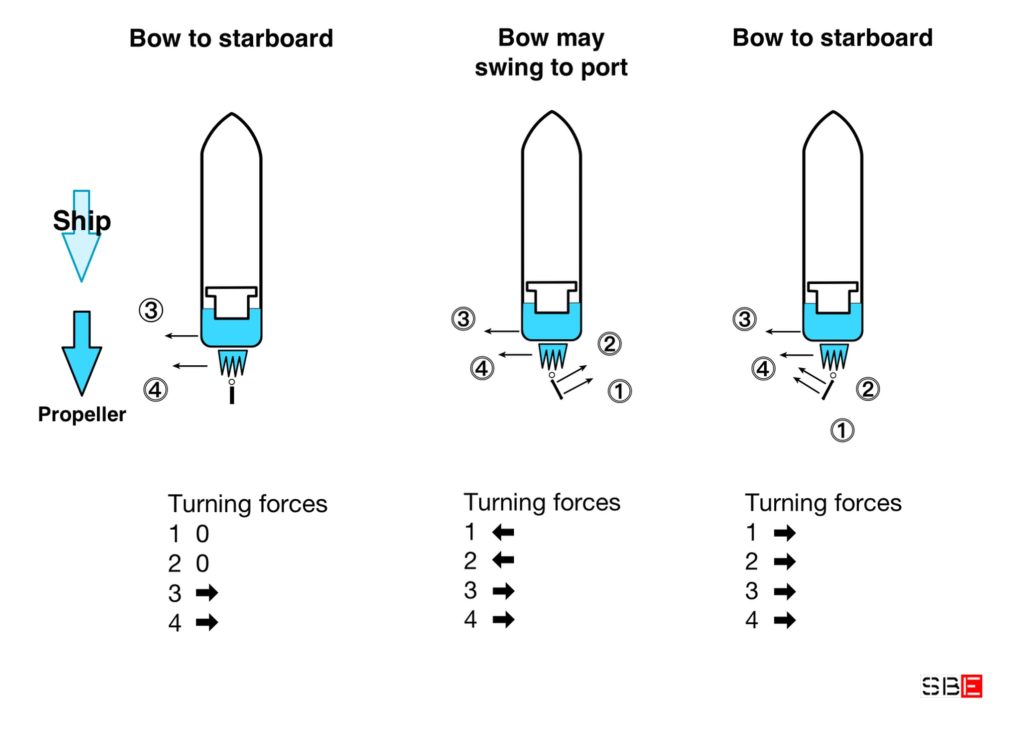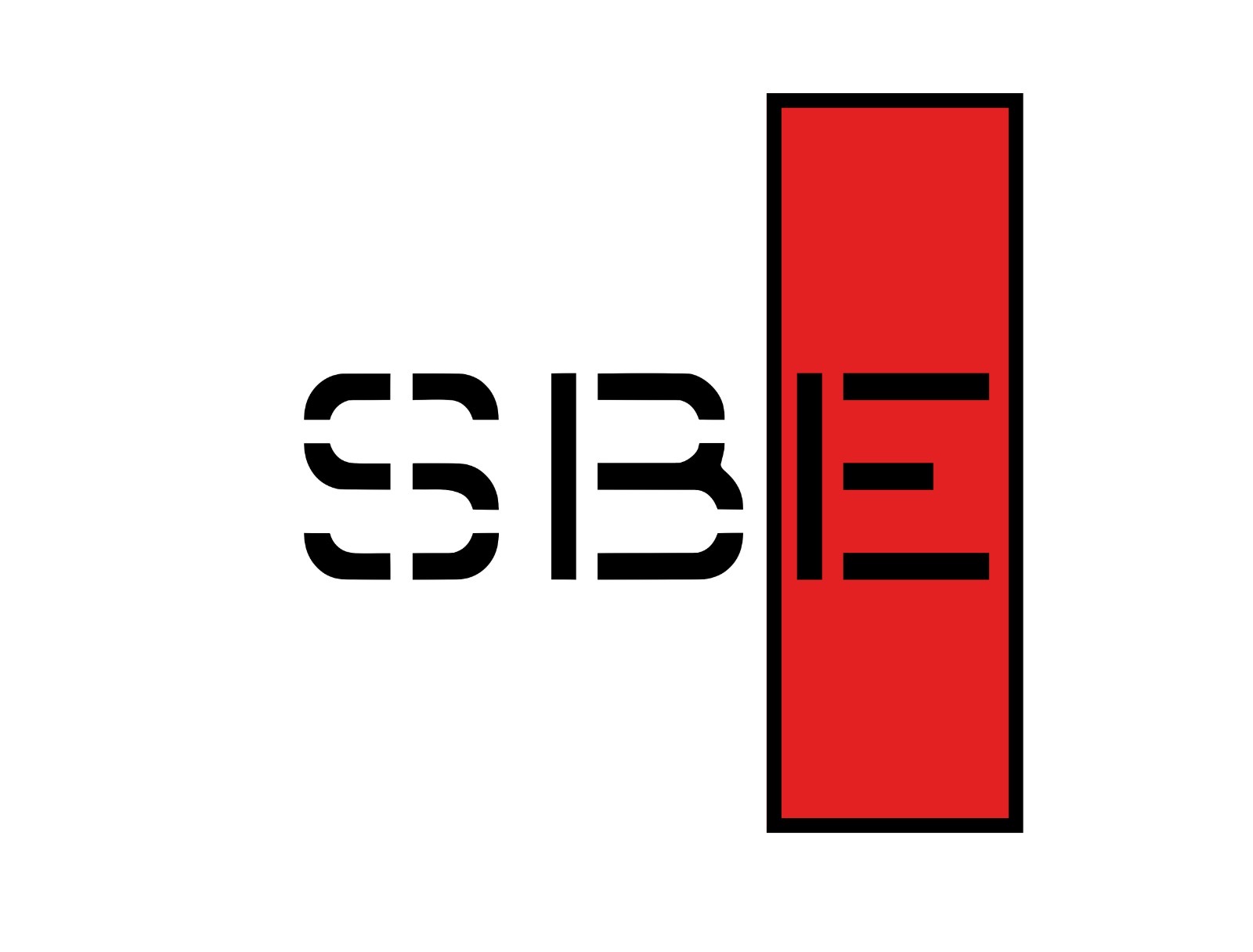The Turning Forces
We cannot address this subject by isolating the rudder from the context in which it works. In manoeuvring, the rudder is a contributing element, together with the propeller to the ship’s directionality, and both are under the influence of numerous external factors that modify their characteristics. We must, however, simplify as much as possible to absorb some basic concepts. To start from a solid base from which to expand our knowledge.
For this reason, we consider a single prop ship fixed-pitch right-handed, which manoeuvres in the absence of disturbing forces. The experience obtained with the exercise of the manoeuvres will be the cornerstone. Therefore, we can conclude that the essential turning forces are four:
- 1 – The effect of the rudder.
- 2 – The current drawn by the propeller.
- 3 – The rejected current in its transverse and longitudinal components.
- 4 – The lateral pressure of the propeller blades.
Propeller plays the primary role, which generates the main turning effect. However, the rudder plays its part in different situations. Let’s see which ones!
Stationary or Forward Moving Ship – Propeller Ahead
In forward motion, the turning effect due to the propeller’s rotation is irrelevant as it is weak and easily correctable by the helmsman. We can only add that this correction is more significant when the propeller is slightly immersed. The blade’s lateral pressure in the most submerged area is always dominant. The rudder, therefore, produces a steering effect that prevails over all the others.
When the ship is stationary, or the ship’s speed is less than that of her propeller, the effect is more significant (maximum slip). The propeller’s stream hits the rudder blade hard on the side, and the ship turns immediately. We can establish a first important concept:
When we fix the bow through a line on the quay or anchor, we can easily steer the stern with a propeller and rudder. Let’s think of the traditional mooring or unmooring manoeuvres using spring or the classic swing at anchor.
A second important concept:
The swing to port is always more accessible than the one to starboard.
The reason is the tendency of the vessels, fixed single right-handed propeller, to swing to port when the rudder is in the middle.
Thanks to the pressure of the propeller blades and the fact that the rudder, placed hard aside, does not undergo the contrasting turning effect of the rejected current on the side not affected by the wake.

Stationary or Receding Ship – Propeller in Reverse
We have already analysed this effect by studying the propeller. We have it since the propeller in reverse when the ship is stationary has a powerful impact that makes the rudder’s effect negligible. The vessel turns to the side where the propeller has its effect.
If, on the other hand, on under-speed vessels, the rudder effect is by no means negligible, but depending on which side it is, it can intervene more or less effective in our manoeuvre.
Rudder to Starboard:
The effect of the rudder is to swing the stern to the starboard, and the bow will probably turn to port. However, two others are added to this effect, the current suction and the lateral pressure of the propeller blades. The first increases the rudder effect, and the second instead contrasts it. These forces can vary, and we can bring the stern to one side or the other in different ways by acting on the speed, stopping the engine, or changing the rudder angle. When running astern, the ship’s tendency will initially be to swing the stern to port, that of the rudder to starboard, and the drawn current to starboard. These two forces can prevail if only the reverse speed is high. Otherwise, the ship will go straight or turn as the propeller tendency (left-handed or right-handed effect). If we stop the propeller, we can increase the rudder’s effectiveness to direct the stern to port or use the engine kicks to keep a straight course.
Rudder to Port
All forces go in the same direction! The rudder and the suction current amplify the propeller’s lateral pressure, and the stern approaches decisively and quickly to starboard.

Ship Advancing – Propeller in Reverse
The ship behaves differently depending on whether the helm is amidship, hard-a-port, or starboard.
Rudder in the Middle
In this case, the engine stops and then runs full astern without intervening on the rudder. The drawn-in current slips on both faces of the rudder without producing effects, while the transverse current is rejected, and lateral pressure of the blades will bring the stern to port. The rudder, therefore, has no impact.
Rudder to Port
In this case, the common rudder effect intervenes, swinging the stern to starboard. This effect weakens quickly with the decreasing speed, and all other effects prevail and move the stern to port. In this manoeuvre, we will have an initial port turn due to the effects of the rudder on the ship in speed, which will change fast into a decisive turning to starboard.
Rudder to Starboard
Also, in this case, the rudder effect intervenes in the first phase and then weakens with the decrease in speed, the only force contrary to the swing to starboard is the drawn current. All other forces combine to bring the stern to port, and, consequently, the bow will fall to starboard.
However, the drawn current will have the opposite trend to the effect of the rudder. As the ship’s speed decreases, she will increase in force and become so great as to stop the swinging. The effects are significantly reduced if the engine is not fully astern but only half or slow astern.
In port manoeuvres performed at low speed, these effects are instead manifested with more significant power since speed is an essential variable for the use and effectiveness of the rudder itself.

Ship Reversing – Propeller in Forwarding Gear
When a ship moves backwards and uses the forward gear, the rudder acts as if the vessel were moving forward. The current rejected by the propeller strongly hits the rudder blades, and the other forces become irrelevant. The ship then turns over on the side where the rudder is.
Rudder in the Middle
Again, the rudder amidship does not affect the turn as the rejected current slips on its two faces. The drawn current also does not affect it as it comes from forward. It runs parallel to the keel. The only two forces acting to turn the stern are the lateral pressure of the blades and the current transversally rejected, which work in the opposite direction to each other.
The lateral pressure brings the stern to the starboard while the transversal rejected current pushes to the port. In practice, we cannot say which will be the result, and the bow will swing to one side or the other depending on which of the two forces prevails, but the swinging will never be violent.
Rudder to Starboard
The only predominant force is the rejected current from the propeller that hits the rudder blade, and therefore the bow will swing to starboard. The other forces are either zero or irrelevant.
Rudder to Port
As above, the only predominant force is the current rejected by the propeller hitting the rudder blades, and the bow will swing to port. The other forces are null except for the generated energy by the lateral pressure of the propeller, which, although minimal and irrelevant in the case of the starboard rudder, contributes to increasing the turn to port.
The ship obeys the rudder for the motion of the propeller, not for the movement of the hull.
Whether the ship moves forward or backwards, once the pushed back current strikes violently on the rudder blades, it turns the ship strikes.

The ship handling and the practice of the manoeuvre start from these bases. The windy and variable sea conditions, currents and vessel characteristics dramatically expand the scenarios. A “rule of thumb” to always keep in mind is that: the ship feels the wind when proceedings astern, and the stern is always looking for deep water.
These effects can amplify or counter the tendency of the stern to turn following the ‘paddle-wheel effect’. It depends on the wind and the ship’s speed. The more intense these two forces, the greater the effects will be.
